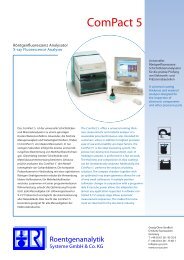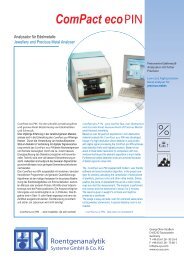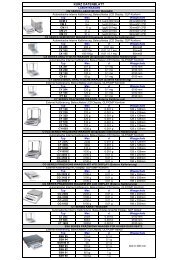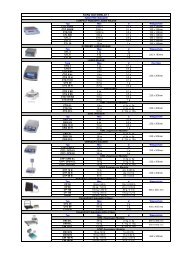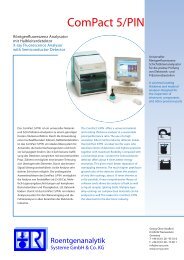Coating Thickness Software for Eagle µ-EDXRF Systems
Coating Thickness Software for Eagle µ-EDXRF Systems
Coating Thickness Software for Eagle µ-EDXRF Systems
You also want an ePaper? Increase the reach of your titles
YUMPU automatically turns print PDFs into web optimized ePapers that Google loves.
6. Creation of a Multi-Layer Application (ex. Au/<br />
Pd/ Ni/ Cu base)<br />
The following procedures define how to analyze up to four (4) mono-element layers. In this example, the<br />
“unknown” sample to be measured against the .c03 file will be 1.9um Au on 1.19um Pd on 2.57um Ni on<br />
Cu base. Generally <strong>for</strong> “unknowns”, the users will have an idea of the target thicknesses. Having this<br />
knowledge is useful in choosing standards. However, if the thicknesses are completely unknown, the user<br />
will have to use the .c03 application from FunMaster (based on bulk intensities) to calculate standardless<br />
values in ReCalib <strong>for</strong> the unknown sample, which can give an idea of which coating standards to choose.<br />
The FunMaster routine will require saving the appropriate scatter spectrum, and the pure bulk intensities <strong>for</strong><br />
Au, Pd, Ni, and Cu. It will also be necessary to gather coating standards <strong>for</strong> .ADT files. For optimal results,<br />
choose at least two coating standards <strong>for</strong> each layer; one thinner standard, and one thicker, so that the<br />
layers are “bracketed.” For example, an appropriate set of coating standards <strong>for</strong> this scenario would be:<br />
Available Standards:<br />
• 0.47um, 4.08um Au (layer 3 – top Au)<br />
• 0.61um, 3.02um Pd (layer 2 – middle Pd)<br />
• 1.04um, 9.45um Ni (layer 1 – bottom Ni)<br />
• Cu base<br />
The FunMaster routine <strong>for</strong> multi-layers follows a similar procedure to that already described <strong>for</strong> single-layers.<br />
However, after the FunMaster procedure, there will now be two separate stages/procedures to follow in the<br />
multi-layer ReCalib routine. The first stage will require each layer element to be calibrated individually as<br />
single-layer systems. That is, Au on Cu base, Pd on Cu base, and Ni on Cu base. Spectra and .ADT files<br />
should be acquired <strong>for</strong> each of the individual single layers on a copper base.<br />
For the second stage, the inter-layer effects associated with lower layer’s characteristic radiation passing<br />
through the upper layers must be accounted <strong>for</strong>. To do so, the user must acquire spectra and .ADT files <strong>for</strong><br />
all layer combinations which could exhibit inter-layer effects. Thus, <strong>for</strong> this example, the user would use<br />
the coating standards listed above to acquire .ADT files <strong>for</strong> all double layer (Au on Pd, Au on Ni, and<br />
Pd on Ni).combinations. It is optional to create triple layer .ADT file(s) as well. Triple layer standard<br />
measurements can be useful <strong>for</strong> checking the quality of the recalibration routine later. The order of the<br />
layers cannot be altered, since that would no longer represent the inter-layer effects present in the sample.<br />
Because there are two standards of each element, there are many permutations. For instance, examples of<br />
appropriate layer systems <strong>for</strong> use as .ADT files <strong>for</strong> the second stage of this multi-layer example would be:<br />
Double Layer .ADT Files<br />
• Au on Pd on Cu base (3>2) - signifies correction <strong>for</strong> “the effect of the upper Au layer [3] on the<br />
transmission of the Pd X-rays [ layer 2] to the detector.”<br />
o 0.47um Au / 3.02um Pd<br />
o 4.08um Au / 3.02um Pd<br />
• Au on Ni on Cu base (3>1)<br />
o 0.47um Au / 9.45um Ni<br />
o 4.08um Au / 9.45um Ni<br />
• Pd on Ni on Cu base (2>1)<br />
4.1.2 <strong>Coating</strong> <strong>Thickness</strong> Results Panel in Vision32 44



